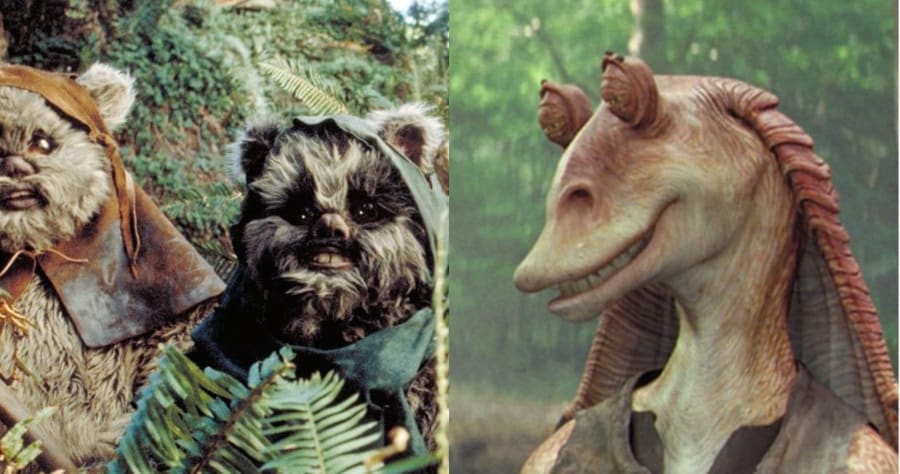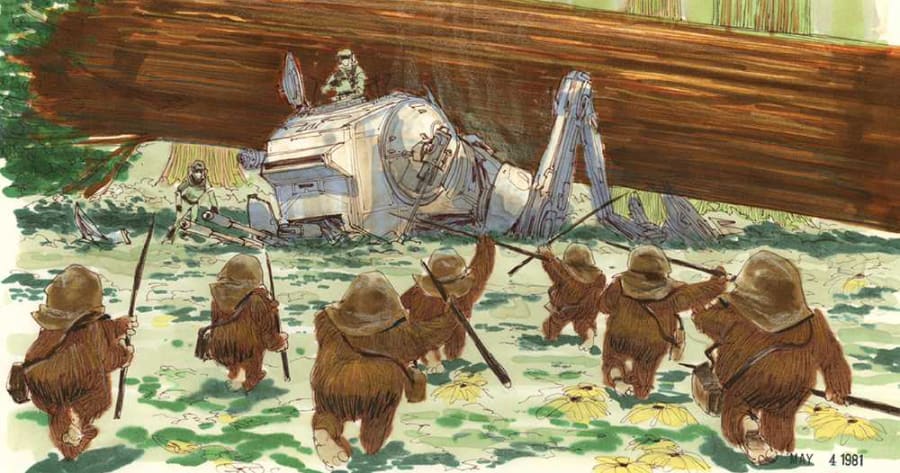 2018 marks the 35th anniversary of "Star Wars: Return of the Jedi," the third film in George Lucas' initial -- and, for a while at least, only -- trilogy.
2018 marks the 35th anniversary of "Star Wars: Return of the Jedi," the third film in George Lucas' initial -- and, for a while at least, only -- trilogy.
And while it's easy to get swept up in the nostalgia, especially since it perfectly coincides with the release of "Solo: A Star Wars Story," in many ways "Return of the Jedi" marked the end of the "Star Wars" that we knew and loved. It signaled the end in which fairly standard fairy tale tropes are deepened and complicated, lacquered with layers of New Age mysticism and Eastern philosophy, while officially ushering in the next phase of the franchise (more simplistic storytelling aimed more squarely at children). The cycle that began with the third film of the original trilogy has only recently been broken, thanks to the new "saga" films, in which directors raised on the material have been fearless in both reconstructing and deconstructing the series' mythology and its accompanying characters.
In short: "Return of the Jedi" was the beginning of the end.
But let's take it back a little bit.1980's "The Empire Strikes Back" was, in many ways, a grand experiment -- one in which Lucas, the writer-director of the original film and the guiding creative force of the franchise, tried to step away. The first film had turned his struggling operation into a full-fledged company, one that demanded management. So he passed the baton to prickly journeyman filmmaker Irvin Kershner.
Lucas assumed that Kershner would simply follow the map that Lucas and screenwriter Lawrence Kasdan (brought in after notable screenwriter and novelist Leigh Brackett had handed in one largely unrecognizable draft before passing away) had laid out in front of him. But Kershner turned out to be more of an artist, insisting on multiple takes and emphasizing exploration and improvisation. This, as recounted in Brian May Jones' indispensable biography "George Lucas: A Life," grated on Lucas, who was both extending credit to cover the ballooning budget and cracking down on what he perceived as Kershner's flights of creative fancy.
Ultimately, the push-and-pull between Kershner and Lucas gifted us with the greatest entry in the franchise (to this day). Without Kershner's willingness to go off the page, we would have never had Han and Leia's unforgettable farewell (among other things).
"The Empire Strikes Back" was a glorious melting pot of artists at the top of their game; not only Kershner, but Jim Henson and Frank Oz (who helped create Yoda), along with a more emboldened cast who came to set with fully formed ideas about where their characters should go, and people like editor Paul Hirsch, cinematographer Peter Suschitzky, and producer Gary Kurtz. These were the voices (some louder and more combative than others) that made the movie sing. They were also the ones that made Lucas the most enraged.
When it came to "Return of the Jedi," he wiped the slate clean, creatively. Of the geniuses that brought "Empire Strikes Back" to life, only Oz was spared, returning in a much more limited capacity (a kind of puppet cameo). Lucas wanted to regain control of what he thought was essentially his vision, no matter the filmmaker actually behind the camera.So he hired Richard Marquand to direct, and he did so with a machinelike efficiency. There was no flair, no sense of pacing or spectacle, just a measured hitting of beats and, from all accounts, a genial outlook that made him a perfect doormat. (Kurtz, who had been a key ally of Lucas', felt the decision to base the film around another Death Star, reductive, and quit.) And Lucas was paying greater and greater attention to the business side of the operation. He was fond of creating characters that could easily sell toys and keenly aware of the "toyetic" nature of his movies. (This was a phrase coined by a Kenner executive who complained that "Close Encounters of the Third Kind" didn't have enough potential licensing possibilities.)
All of his more commercial inclinations were ultimately focused on one aspect of the movie: the Ewoks.
As far back as Lucas' original, unwieldy treatment for the first "Star Wars" movie, he wanted to see an indigenous, less sophisticated society rise up against the evil Galactic Empire. (In that version, it was the Wookiees, an idea he would return to in the prequels.)
For "Return of the Jedi," it was decided that it would be the inhabitants of the forest moon of Endor, a key spot to the Empire in their construction of the new Death Star. And they went through many designs, originating as creepy, reptile-ish creatures. According to Jones, "Lucas had sent the characters back through design and again and again, finally settling on a cuddly teddy bear-like look."
It was enough to send Ralph McQuarrie packing; he was the illustrator responsible for the franchise's most iconic designs (he's still being cribbed from on shows like "Star Wars: Rebels" and in the Star Wars: Galaxy's Edge theme park project). He "threw up his hands in resignation" over the development of the Ewoks. "There was a feeling that it was maybe too obvious a marketing idea," said one designer (to Jones). "I think Ralph didn't like them too much." Ultimately, Joe Johnston, another talented designer (and future director) would settle on a sweet design that Lucas would approve.
And, in the end, "Both cast and crew alike found his new heroes somewhat grating." Of course, this excluded Lucas.
He instructed second-unit director Roger Christian to get as much footage of the creatures as he could, particularly in the celebratory final scene. It was enough for Christian to request removal from that unit. "George loved them. Nobody else did," said Christian.
Looking back on the film, they really are grating, and their cutesy look, pidgin speech patterns, and prepackaged aesthetic, would be a harbinger of the prequels to come. Even Lucas' backed-in political subtext, with the Ewok/Empire conflict acting as an obvious stand-in for the Vietnam War, was neutered by just how cloying they were. The Vietcong were a lot of things, but huggable was not one of them.
When Lucas returned to "Return of the Jedi" for the "special edition" updates (first in 1997 theatrical re-releases and then subsequently in home video debuts), he made the connection between the film and his nascent prequel trilogy even more explicit: At the end of "Return of the Jedi," he subtracted footage of the Ewok celebration (the same footage that he was so keen on getting during principal photography), instead choosing to cut around to different planets, as they celebrated the downfall of the Empire. These planets included Naboo and Coruscant -- two very important settings for the trilogy -- and featured the kind of busy, overstuffed CGI cacophony that was another hallmark of the later films. The prequels are terrible films, but they are singularly George Lucas films. He directed all three and either wrote or co-wrote all of them, too.
The prequels are terrible films, but they are singularly George Lucas films. He directed all three and either wrote or co-wrote all of them, too.
He paid for them and didn't have any outside help, besides asking Steven Spielberg for assistance staging the climactic lightsaber battle in "Revenge of the Sith." The prequels were hermetically sealed creations, springing forth from Lucas' mind and controlled -- tightly -- at every level by him.
It's suggested in Jones' biography that his greatest artistic accomplishments came when he was getting creative pushback from other likeminded people; the Kershners of his world. When he became, in essence, a solo act, that vitality (and that humanity) all but evaporated. What we were left with were the prequels, movies that had about as much charm and character as an IRS audit, crammed with wooden dialogue, instantly-dated visual effects, and erratic pacing.
But, on all three movies, nobody ever told Lucas "no."
After "Return of the Jedi" came out, Lucas did an interview with Rolling Stone magazine. "Dare to be cute. The worst we could do is get criticized for it," Lucas said, somewhat defiantly.
Sadly, being cute is what would define him as an artist and his franchise as a whole, for decades afterwards, when the commerciality of cuteness was seemingly all he cared about.
from Moviefone News RSS Feed - Moviefone.com https://ift.tt/2IHoE3y
via IFTTT
No comments:
Post a Comment